| As you learned in Table 33.1, Mac OS X supports a large number of network services. To access these services, you must configure each machine that will be using them. This involves configuring the particular machine that will be providing those services (the server) and then enabling access to those services on various machines on the network that will be accessing those services (the clients). Explaining how to configure each of the possible services is beyond the scope of this book. However, learning about some examples of services you are likely to use will enable you to configure the others. Some services you'll want to take advantage of on most networks are the following: File sharing FTP server Windows file sharing Printer sharing Web server
 To learn how to share files with Windows computers, p. 968. To learn how to share files with Windows computers, p. 968.
 To learn how to share the printers attached to a Mac OS X machine, p. 882. To learn how to share the printers attached to a Mac OS X machine, p. 882.
 To learn how to host websites from a Mac OS X machine, p. 514. To learn how to host websites from a Mac OS X machine, p. 514.
Configuring and Using File Sharing The Mac OS has long provided peer-to-peer file-sharing capabilities to enable Macintosh computers on a network to share files. Mac OS X provides much more robust file sharing services along with more tools you can use to control and configure a network. NOTE Peer-to-peer file sharing implies that the files being shared are stored on workstations that people use to accomplish work. The other type of file sharing is based on a sever/client arrangement in which the primary purpose of the server machine is to provide network resources, such as files to share. The technology involved is similar. If you are managing a relatively small network, you are probably not likely to have a dedicated server on it, but that's okay because peer-to-peer file sharing works just as well for these kinds of networks.
Under Mac OS X, you can share files with Macs running Mac OS X, Macs running OS 9 and earlier, Windows file servers, and Unix file servers. For other Macs running Mac OS X, you can use AppleTalk for file sharing or use TCP/IP. For Macs running earlier versions of the Mac OS (such as Mac OS 9), you can use AppleTalk to share files. For Windows and Unix, you can use SMB and CIFS services. When connecting to other Macs for file sharing, the machines communicate through either TCP/IP or AppleTalk. To log in to a Mac OS X file-sharing machine serving files via TCP/IP, that machine must have an IP address. Typically, this IP address is assigned as part of connecting that machine to the Internet, such as by a DHCP server provided by an Ethernet hub or an AirPort Base Station. Mac OS X includes support for Bonjour, which enables devices to seek out other Bonjour-compatible devices on a network and configure automatically access to those devices. All Macs that have Mac OS X version 10.2 or later are Bonjour aware and can therefore take advantage of this technology to easily and quickly connect to other Macs. However, other devices, such as printers, can also support Bonjour, so those devices can be configured automatically as well. NOTE Interestingly enough (to me anyway), Bonjour is also being used in some "non-computer" devices. For example, TiVos use Bonjour.
AppleTalk is the Mac's original network protocol, and it continues to be supported in Mac OS X. When you are connecting to Macs running OS version 8.6 or earlier, you have to use AppleTalk as support for file sharing over TCP/IP, which was added in Mac OS 9.0. In the next chapter, you will learn how to share an Internet account using a DHCP server. Such a server assigns IP addresses to the machines connected to it. The D stands for dynamic, meaning these addresses can change. This can make locating a specific machine by its IP address tough because each machine's address can be changed by the DHCP server. Fortunately, with most DHCP servers, you can choose to manually assign IP addresses to the devices attached to it. When you do this, machines have the same IP address even though they are using a DHCP server to obtain that address. With Bonjour, you don't need to worry about the IP addresses of individual machines because your Mac seeks out the devices that are communicating on a network and automatically configures access to those devices. NOTE If other devices on your network, such as printers, have dynamic IP addresses assigned to them and you use the IP address to configure that device, you can lose the connection to those devices when the DHCP server assigns a new address to them. (This typically happens if the hub loses power for some reason or the device is removed from the network for a while.) In such cases, you need to reconfigure any computers that access the device with the new address assigned by the DHCP server. For such devices, consider assigning a static address that remains constant for that device.
To identify the current IP address of a Mac OS X machine, open the Services tab of the Sharing pane of the System Preferences application. Select and activate the service in which you are interested; the current address will be shown at the bottom of the pane (see Figure 33.2). Figure 33.2. When you select an active service, such as Personal File Sharing, the URL to connect to that service is shown at the bottom of the Sharing pane (in this case, you can see that the current IP address of the Mac is 10.0.1.9). 
You can also use the machine's name to identify it from other machines that support Bonjour. The machine name is shown in the Computer Name field at the top of the pane and also at the bottom of the pane as part of the address information (in Figure 33.2, you can see that the Mac's name is Brad Miser's Power Mac G4). TIP To identify the current IP address of a Mac OS 9 machine, open the File Sharing control panel.
Configuring File Sharing on a Mac Running Mac OS X To share the files stored a Mac OS X machine, you must enable the Personal File Sharing service on that computer. This includes turning on the File Sharing service, turning on AppleTalk (if you will be sharing files with Mac OS 9 machines), naming the machine, and so on. TIP If your purpose in file sharing is one-wayfor example, enabling others to download files from a specific machine but not to upload files to itconsider using FTP services on a machine rather than file sharing. You will learn how to provide FTP services in a later section of this chapter. You can also use web sharing to enable people to download files from a Mac OS X machine.
What's in a Name? Your Mac actually has two names associated with it. One is the computer name, which by default is a combination of the first user's name and the word Computer. The other name is that device's hostname, which is actually the name used when the device is accessed over a network. By default, the hostname and the computer name are the same, except your Mac automatically removes any characters, such as spaces, that aren't permitted in a hostname. Any changes you make to the computer name are automatically made in the hostname. However, you can manually set the hostname for a machine to be something different from its computer name. To do this, click the Edit button at the top of the Sharing pane. In the resulting sheet, enter the hostname of the Mac. The hostname always ends in .local. |
The following steps assume that a Mac has access to the network (via Ethernet or AirPort) and that the default security privileges are in place on the file-sharing machine. You can change the default privileges for items you share to make them more or less available as you will learn in a later section of this chapter. To provide file sharing services from a Mac running Mac OS X, do the following steps: 1. | Open the System Preferences application.
| 2. | Click the Sharing icon to open the Sharing pane (see Figure 33.3). At the top of the pane are the computer's name and its hostname.
Figure 33.3. You enable the network services a Mac provides by using the controls on the Services tab of the Sharing pane. 
The Sharing pane has three tabs. The Services tab is used to view and configure the services the machine will provide. You use the Firewall tab to enable and configure the machine's firewall, and you use the Internet tab to enable a machine to share its Internet connection with other machines.
 To learn how to configure a Macs firewall, see "Defending Your Mac Against Net Hackers," p. 1032. To learn how to configure a Macs firewall, see "Defending Your Mac Against Net Hackers," p. 1032.
 To learn how to share an Internet connection among the devices on the network, p. 973. To learn how to share an Internet connection among the devices on the network, p. 973.
| 3. | Provide the computer's name by entering a name in the Computer Name text box; use a name that will help others on the network easily identify the machine. The default computer name is the first user's name entered when the machine was registered, with an apostrophe, an s, and the word Computer tacked onto it. You can use the default computer name or change it to one you prefer.
After you provide a name, the machine's hostname is automatically created. Some characters, such as spaces, aren't allowed in a hostname, which is the name by which the machine is identified on the network. If you enter such characters in the computer name, the machine name that people see on the network won't be exactly what you entered. For example, if you include a space in the computer name, it is replaced by a hyphen for the machine's network name. The Mac automatically removes and replaces any disallowed characters.
| 4. | If you want to manually enter a hostname, click the Edit button; then, in the resulting sheet, enter the hostname for the machine and click OK. The extension .local is added to the hostname you type to indicate that the host is on the local network.
| 5. | Select the service you want to activate on the machine, such as Personal File Sharing.
| 6. | Click the Start button to turn on the selected service. For example, if you selected Personal File Sharing, that service is activated; after a moment or two its status becomes On and you see the AFP address of the machine and the browsing name (which is the name by which others on the network will be able to identify the computer when they browse the network) at the bottom of the pane. When you select and enable other services, information related to those services is shown in the pane instead. When the service is running, the Start button becomes the Stop button.
TIP You can also start a service by clicking its On check box. If you will be sharing files with Macs running a version of the Mac OS older than Mac OS X and those machines don't allow file sharing over TCP/IP, you need to make AppleTalk active on the Mac OS X machine. If the machines to which you will be providing file-sharing services do allow file sharing over TCP/IP, you don't need AppleTalk and can skip to step 12.
CAUTION If you don't need to use AppleTalk to use file sharing, leave it off. AppleTalk can sometimes interfere with other network services, such as TCP/IP services to the Internet. AppleTalk can also make your machine visible to a local or wide area AppleTalk network. | 7. | Open the Network pane of the System Preferences application.
| 8. | Select the network port over which AppleTalk access will be provided on the Show menu. For example, select Built-in Ethernet to enable machines to use the AppleTalk protocol over Ethernet. Select AirPort to provide AppleTalk over an AirPort network.
NOTE You can provide AppleTalk over only a single network port at a time. For example, you can provide AppleTalk over Ethernet or over AirPort, but not both at the same time. | 9. | Click the AppleTalk tab and check the "Make AppleTalk Active" check box. The computer name you entered in the Sharing pane is shown next to the text Computer Name.
| 10. | If you have AppleTalk zones on your network, select the zone from the AppleTalk Zone pop-up menu (if there aren't any zones, this pop-up menu will be inactive). You can configure AppleTalk zones using the Configure pop-up menu (select Manually if you want to manually configure the network or Automatically to have your Mac configure it automatically).
| 11. | Click Apply Now. AppleTalk services will become active on the computer.
| 12. | Review the services you have configured on the Sharing pane (see Figure 33.4).
Figure 33.4. This Mac is providing file-sharing services to other Macs and is sharing the printers connected to it. 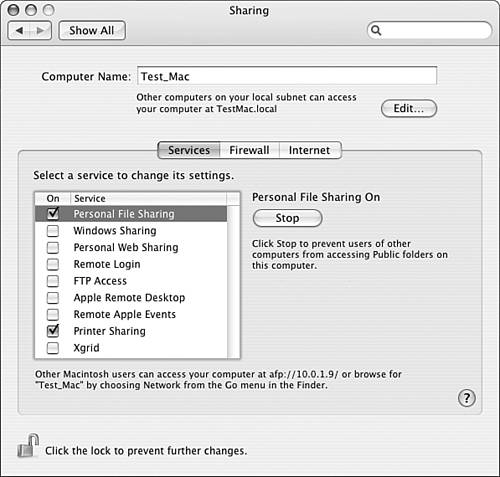
|
Using Firewalls and Network Services If you have a firewall installed on the machine you are configuring as a server, you must configure that firewall to allow the type of access needed for others to access it from the network. For example, to enable the machine to provide file sharing services, you must configure the firewall to allow machines from the network to connect to the file server. With some firewalls, you can allow access to specific services, such as AFP, only from specific IP addresses. All other requests for services will be denied. If you use the Mac OS X built-in firewall that you can enable on the Firewall tab, the services you enable on the Services tab are allowed automatically. You can use the Firewall tab of the Sharing pane to manually configure the services that are allowed if you need to. If you use another type of firewall or configure the built-in firewall using another method (such as the Unix commands), you must enable access to the services you are providing through that firewall. Similarly, if some machines on your network are connected through a Graphite AirPort base station, you won't be able to access those machines from machines connected outside the AirPort network, such as via Ethernet. Because an AirPort base station provides NAT protection of the machines it connects, machines outside the AirPort network can't see any of the machines on the AirPort network unless the base station allows bridging between the wired and wireless networks. By default, you have to manually configure a Graphite base station to allow bridging. On newer base stations, bridging is automatically provided when you connect the station's Ethernet port to the wired network. Always be aware of the security settings of the networks you are configuring and using. Sometimes, you can waste a lot of time troubleshooting a network problem that is actually a case of things working just as planned (such as when you try to figure out why no one can connect to a machine protected by a firewall that isn't configured to allow those services to be accessed on the machine). Accessing Shared Files from a Mac OS X Computer There are two basic ways you can access a server. One is to browse the network for available servers. The other is to move to the services on a machine directly using the URL for the specific service you want to access. In either case, when you connect to a server, you must log in to that server to access its resources. You can log in under a user account that is valid for that server, or you can log in as a guest. When you log in under a valid user account, you have access to all the items on that machine just as if you were logged in to the machine directly (rather than over a network). If you are logged in as a guest, you can access only the items on the machine that allow public access, such as each user's Public folder. NOTE To access a network resource by browsing, it must support Bonjour, SMB, or AppleTalk. If not, you have to access it by entering its URL via the Connect to Server command.
To access shared files stored on a Mac OS X computer that is sharing its files from a Mac OS X machine by browsing the network, do the following steps: 1. | Open a Finder window and select the Network directory on the Places sidebar, select Go, Network or press Shift- -K. The Network directory will appear. Depending on the network to which you are connected, you will see a number of icons representing various network resources available to you. -K. The Network directory will appear. Depending on the network to which you are connected, you will see a number of icons representing various network resources available to you.
NOTE It can take a few minutes for your Mac to successfully browse the network to which it is connected. After you start the browse process, if you don't see the resources you think you should, refresh the Network window by moving away from it and then back again or by clicking its icon to update the list of available network resources. | 2. | To access other Macs providing services, select the My Network icon if you see it; if not, the individual servers with which you can work will appear directly under the Network folder. You will see the names of the computers on your network that are providing services to you (see Figure 33.5).
Figure 33.5. The My Network folder provides access to other Macs providing services on your network; in this case, I can access three other Macs. 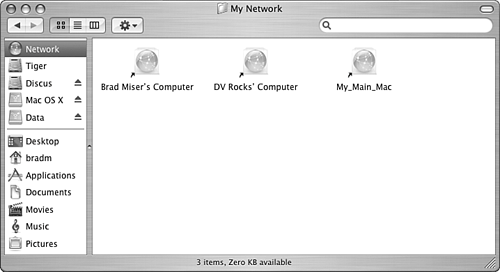
NOTE The icon labeled Servers actually points to the current machine. If you open it, you see the computer on which you are working. If you open that, you jump to the Computer folder. TIP Server icons you access over a network have the globe icon that is similar to the icon for the Network directory. A server's icon also indicates its status. When the icon is in color, you are currently connected to that server and its resources are available to you. When the icon is shaded, you are not connected to the server. | 3. | Double-click the icon for the server and services you want to access. The Connect To Server dialog box will appear (see Figure 33.6).
Figure 33.6. You use this dialog box to log in to a server. 
TIP View the My Network folder in Column view and select the server you want to access. In the Preview column, you'll see the server's icon and the Connect button. Click the Connect button to connect to the machine providing services to you. | 4. | To log in as a registered user, which provides the same access to resources you would have when you log in directly to that machine, click the Registered User radio button and enter the username and password for the account under which you want to log in. If you don't have log in information for a specific user account on the machine to which you are connected, click the Guest radio button instead. Click Connect to connect to the server. A window will appear that lists each volume or user's Home folder (which will be the Home folder of the user account under which you logged in) you can access.
TIP Check the "Remember password in keychain" check box in the Connect to Server dialog box to add a network resource's login information to your keychain. The next time you access that resource, the login information will be input automatically so you can just click Connect to connect to it. | 5. | Select the volume or Home folder you want to use and click OK. The server's volume you selected, such as a Home folder, will appear in the Places sidebar in the Finder window. Select the resource that was mounted to work with it (see Figure 33.7). The resources that appear depend on the user account under which you are logged in. If you logged in as a guest, you can access only public resources.
Figure 33.7. The volume called bmiser is my Home folder on a different Mac that I am accessing over a network. 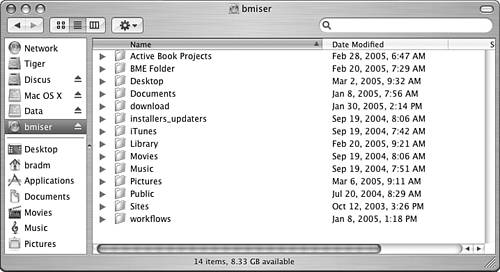
NOTE Network volumes are represented by the globe icon instead of the disk icon, as you can see in Figure 33.7. | 6. | Open the folders available via the shared resource to work with them. For example, you can open files, drag them to your Mac to copy them, and so on.
|
 | If you can't see a server when you browse, see "I Can't Access a Server" in the "Troubleshooting" section at the end of this chapter. |
For more precise access to services on a Bonjour machine (such as to choose to access FTP services when file sharing and FTP are being provided) or to access services on a machine that doesn't support Bonjour, you can use a computer's address to access it manually. To do so, perform the following steps: 1. | From the Finder, select Go, Connect to Server ( -K). The "Connect to Server" dialog box will appear (see Figure 33.8). -K). The "Connect to Server" dialog box will appear (see Figure 33.8).
Figure 33.8. Use the "Connect to Server" dialog box to manually move to servers. 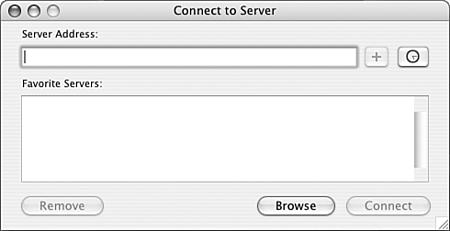
TIP If you click the Browse button, you move to a Finder window showing the Network directory; this does the same thing as selecting Network on the Places sidebar. | 2. | Type the server address you want to access in the Server Address box. The address you use depends on how you want to access the server. For example, to open all of a computer's resources, type its hostname, which is hostname.local, where hostname is the hostname of the machine you are accessing. To access file-sharing services, use the URL for File Sharing services, which will be something such as afp://10.0.1.4/. You can obtain the address for the specific service you want to access on the Sharing pane of the System Preferences application on the computer you are accessing over the network. Select the specific service you want to access and the related address will appear at the bottom of the pane.
| 3. | Click Connect. Your Mac will attempt to locate the resource via the address you entered. You can monitor the progress of this via the "Connecting To Server" progress window. If the connection is made successfully, you will see the "Connect to Server" dialog box (see Figure 33.9).
Figure 33.9. Use this dialog box to log in to a network server. 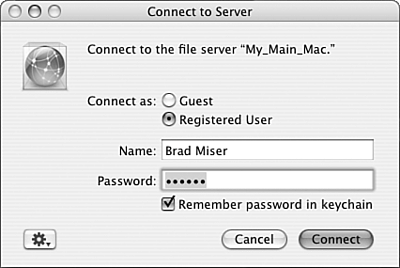
| 4. | Enter the username and password for the account under which you want to log in and click Connect or click the Guest radio button and click Connect instead. The server's volumes that you can access will appear in the select volume dialog box (see Figure 33.10). The resources that appear depend on the user account under which you are logged in. If you logged in as a guest, you can access only public resources.
Figure 33.10. The machine called My_Main_Mac has a number of volumes that can be mounted on the machine being used to access that server. 
| 5. | Select the volume you want to mounthold down the Shift or  key to select multiple volumesand click OK. A Finder window will open and the volumes you chose to access will be shown in the Places sidebar (see Figure 33.11). If you have set mounted servers to appear on the desktop using the Finder preference, they appear on your desktop as well. key to select multiple volumesand click OK. A Finder window will open and the volumes you chose to access will be shown in the Places sidebar (see Figure 33.11). If you have set mounted servers to appear on the desktop using the Finder preference, they appear on your desktop as well.
Figure 33.11. The Home folder called bmiser and the disks called Back-UP Disk and Tiger-1 are being accessed over the local network. 
NOTE In Figure 33.11, you can see that there are two volumes named Tiger. Because the Mac to which the current Mac connected via the network also had a volume named Tiger, Mac OS X appended a -1 to the network volume named Tiger when it mounted that volume on the current Mac. | 6. | Access the network volumes just like those directly connected to or installed in your Mac.
|
If your preferences are set such that mounted volumes appear on your desktop, you will see the shared volumes there as well.  | If the connection is never made and quits or the "Connect to Server dialog box never appears, see "I Can't Access a Server" in the "Troubleshooting" section at the end of this chapter. |
Following are some additional tips about using a Mac OS X machine to access file-sharing services via the Connect to Server command: When you sign on to a Mac OS X file-sharing machine as a registered user, meaning you have a username and password, the Action pop-up menu in the "Connect to Server" dialog box is enabled. If you open this menu, you can choose the Options command to set some preferences related to accessing the file-sharing services on this machine. You can allow a clear-text password (on by default), receive a warning when sending a password in clear text (also on by default), or allow secure connections using the SSH protocol. When you change these settings, you must click OK to save them. You can also change the password for the account under which you are logging in (if the account allows this) by choosing the Change Password command. When you are logged in to a file-sharing machine, you can quickly choose other volumes to mount by opening the Connect To Server dialog box (press  -K), selecting the file server to which you are logged in, and pressing Return. You jump to the Select Volume dialog box (because you are already logged in), and you can select another volume to mount on your machine. Of course, it is easier just to mount all the resources you can access when you first log in. -K), selecting the file server to which you are logged in, and pressing Return. You jump to the Select Volume dialog box (because you are already logged in), and you can select another volume to mount on your machine. Of course, it is easier just to mount all the resources you can access when you first log in. The address to which you most recently connected is remembered in the "Connect to Server" dialog box so you can reconnect to it by opening that dialog box and clicking Connect. To remove access to a network resource, click the Eject button shown next to it in the Places sidebar or select the mounted folder or volume and choose File, Eject or press  -E. -E. To log back in to the same file-sharing machine under a different user account, such as an administrator account, you must log off that machine and repeat the initial login process. You do this by ejecting all the mounted volumes provided by that server. At the upper-right corner of the "Connect to Server" dialog box is the Recent Servers pop-up menu (the Clock icon) that shows a list of the most recent servers you have accessed. You can select a server from this list to return to it, or you can clear the list by selecting Clear Recent Servers. In the lower part of the "Connect to Server" dialog box is the Favorite Servers list. You can add a server to your favorites list by entering its URL and clicking the "Add to Favorites" button (+). You can return to any favorite server by selecting it on the list and clicking Connect. Remove a favorite by selecting it and clicking the Remove button. You can place an alias to a networked volume on your Mac, such as by adding it to the Places sidebar. When you open such an alias, you are prompted to log in to the server and, upon doing so, you can access that volume. If you add the password to your keychain, you will skip the login process.
 | If you are unable to access the file server, see "I Can't Access a Server" in the "Troubleshooting" section at the end of this chapter. |
TIP You can add a network server to the Startup Items tab of the Accounts pane of the System Preferences application to mount that server each time you log in.
Using File Sharing with Mac OS 9 Computers You can use file sharing with Mac OS 9 computers just as you can with Mac OS X machines. The access you have to a Mac OS 9 machine from a Mac OS X machine is determined by the file-sharing settings of the Mac OS 9 machine. NOTE Explaining setting up file sharing on a Mac OS 9 machine is beyond the scope of this chapter. For help, see my book The Mac OS 9 Guide.
When you enable access to a Mac OS X file-sharing machine from a Mac OS 9 machine, the user of the Mac OS 9 machine has the same options as someone who signs on to the file-sharing computer using a Mac OS X machine. For example, if he signs on under a guest account, he can mount any of the Public folders on the file-serving machine. If he logs in under a valid user account, he can use any volumes that user has permission to access on that machine.  | If you have trouble using file sharing from a Mac OS 9 machine, see "My Mac OS 9 Machine Can't Share Files" in the "Troubleshooting" section at the end of this chapter. |
NOTE Remember that Macs running older versions of the Mac OS must be configured to allow file sharing via TCP/IP; otherwise, you must turn on AppleTalk for the Mac OS X file server.
Configuring and Using FTP Services Among its other network services, Mac OS X also includes a built-in File Transfer Protocol (FTP) server. Using an FTP server can be an even more convenient way to enable others to access files stored on a particular machine. Other people can use a standard web browser or FTP application to download files stored on your Mac via the FTP services you enable on a machine. CAUTION Granting FTP access to a machine has security implications that are beyond what I have room to cover in this chapter. If you intend to use the FTP services on a machine that has sensitive data on it, you should investigate the implications of running FTP services on a Mac under Mac OS X that has data on it you need to protect. You can sometimes move outside the particular Home directory for the account under which you log in to the FTP site, so be very careful about granting FTP access to a machine unless you are very sure about the person who will be using it.
Configuring FTP services under Mac OS X is similar to providing file-sharing services: 1. | Open the Services tab of the Sharing pane of the System Preferences application.
| 2. | Select the FTP Access service.
TIP You can also activate FTP services by checking the FTP Access On check box. | 3. | Click Start. FTP services will start up, and the FTP address for the machine will be shown at the bottom of the pane.
|
To access the FTP server, browse for the network resource or move to the FTP address via the "Connect to Server" dialog box. You can also use a web browser or an FTP client and use the URL ftp://ip_address/, where ip_address is the IP address of the machine providing FTP services (remember that the FTP URL for the machine is shown at the bottom of the Services tab when you select the FTP Access service). You will see the "FTP File System Authentication" dialog box (see Figure 33.12). In this dialog box, you are prompted to enter the username and password for the services you are accessing; enter the short name and the password for the user account whose Home directory you want to access and click OK. Figure 33.12. When you access an FTP server, you will use this dialog box to log into that service. 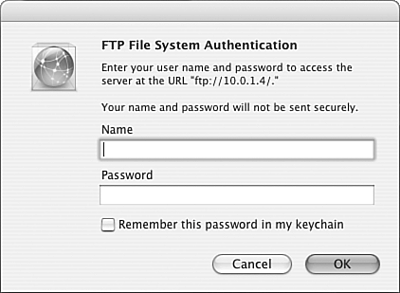
If you use the Finder or a web browser to access the FTP services, a Finder window will open and the folders you can access will appear. You can open any accessible folders to see the files they contain. To copy a file onto your Mac, drag it from the FTP resource onto your computer. NOTE When you use the Finder or a Web browser, FTP is a one-way service. You can only copy files from the FTP server to your Mac; you can't move files from your Mac to the FTP server as you can with File Sharing. For this reason, use FTP when you don't want people changing files on your Mac but only want to provide copies of files stored on your machine. If you use a dedicated FTP application, you can move files in both directions via FTP.
If you use a non-administrator account to log in to the FTP server, you have access to the entire Home directory for that user account. If you log in under an administrator account, you have wider access to files on the machine.  | If you can't access the FTP site on a machine, see "I Can't See the FTP Site" in the "Troubleshooting" section at the end of this chapter. If you are initially able to enter the FTP site, but then it stops working, see "FTP Access Was Working but Now It Isn't" in the "Troubleshooting" section at the end of this chapter. |
|
 To learn how to share files with Windows computers,
To learn how to share files with Windows computers, 









